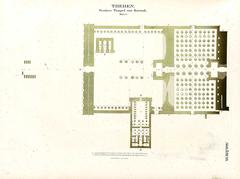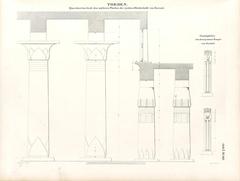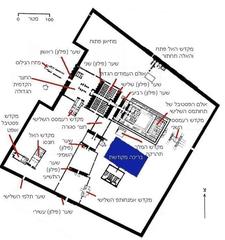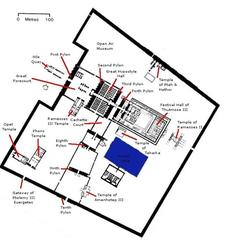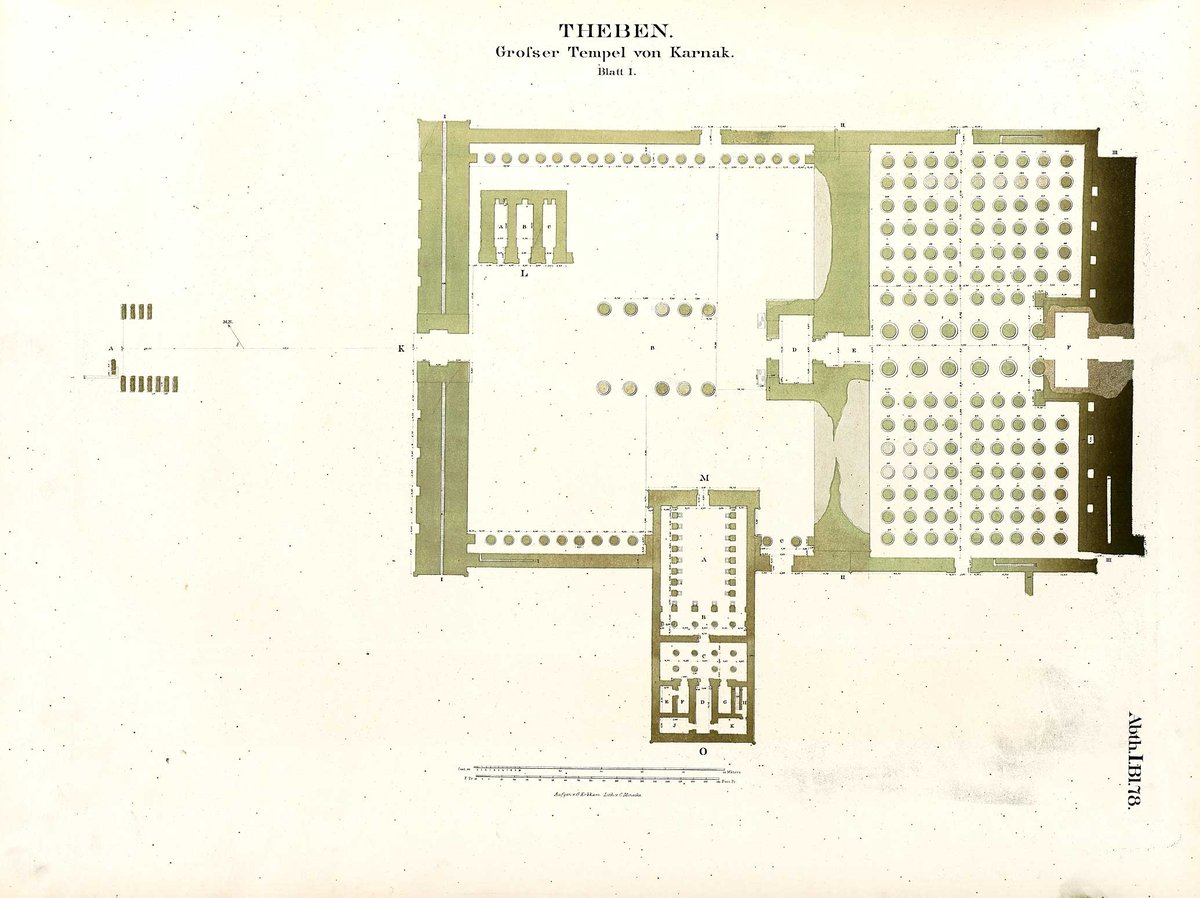
Guide to Visiting the Great Hypostyle Hall
Date: 17/08/2024
Introduction
The Great Hypostyle Hall, located within the Karnak Temple Complex in Luxor, Egypt, stands as one of the most remarkable architectural and religious achievements of ancient Egyptian civilization. Constructed primarily during the reigns of Pharaoh Seti I and his son Ramses II around 1250 B.C.E., the hall covers an expansive area of approximately 50,000 square feet and features 134 towering sandstone columns arranged in 16 rows (Smarthistory). The central twelve columns, reaching an impressive height of 69 feet, create a clerestory effect that allows natural light to illuminate the hall, enhancing its mystical ambiance (Intrepid Scout).
The Hypostyle Hall was not merely an architectural marvel but also held significant religious symbolism. The columns, designed to resemble papyrus stalks, symbolized creation and rebirth, while the astronomical imagery on the ceiling depicted the sky. This design was intended to reflect the ancient Egyptian concept of “zep tepi,” or “the first time,” which refers to the mythical beginnings of the world (Smarthistory). Over the centuries, the site evolved with contributions from successive pharaohs, each adding their own artistic and religious elements, making it a palimpsest of Egyptian history (Earth Trekkers).
Today, the Great Hypostyle Hall continues to captivate scholars and tourists alike, offering a unique glimpse into the grandeur of ancient Egyptian civilization. This guide provides a comprehensive overview of the hall’s history, architectural significance, and practical visitor information, ensuring that you can make the most of your visit to this awe-inspiring site.
Table of Contents
- [Historical Background](#historical-backgroundhistorical-background)
- [Construction and Architectural Significance](#construction-and-architectural-significanceconstruction-and-architectural-significance)
- [Symbolism and Religious Importance](#symbolism-and-religious-importancesymbolism-and-religious-importance)
- [Historical Context and Evolution](#historical-context-and-evolutionhistorical-context-and-evolution)
- [Contributions of Notable Pharaohs](#contributions-of-notable-pharaohscontributions-of-notable-pharaohs)
- [Artistic and Cultural Impact](#artistic-and-cultural-impactartistic-and-cultural-impact)
- [Preservation and Modern-Day Significance](#preservation-and-modern-day-significancepreservation-and-modern-day-significance)
- [Visitor Experience](#visitor-experiencevisitor-experience)
- [Practical Information for Visitors](#practical-information-for-visitorspractical-information-for-visitors)
- [Nearby Attractions and Travel Tips](#nearby-attractions-and-travel-tipsnearby-attractions-and-travel-tips)
- [Accessibility Information](#accessibility-informationaccessibility-information)
- [FAQ](#faqfaq)
Historical Background
Construction and Architectural Significance
The Great Hypostyle Hall at Karnak Temple is one of the most awe-inspiring architectural feats of ancient Egypt. Constructed during the Ramesside period, it was initiated by Pharaoh Seti I and completed by his son, Ramses II, around 1250 B.C.E. (Smarthistory). The hall covers an area of approximately 50,000 square feet and contains 134 massive sandstone columns arranged in 16 rows. The central twelve columns stand at an impressive height of 69 feet, while the remaining columns are slightly shorter, creating a clerestory effect that allows natural light to filter into the hall (Intrepid Scout).
Symbolism and Religious Importance
The Hypostyle Hall was not merely an architectural marvel but also a significant religious space. The columns were designed to resemble papyrus stalks, a plant that held great symbolic meaning in ancient Egyptian culture, representing creation and rebirth. The hall’s ceiling, adorned with astronomical imagery, symbolized the sky, while the columns represented the marsh-like environment of creation (Smarthistory). This design was intended to reflect the concept of “zep tepi,” or “the first time,” which refers to the mythical beginnings of the world when the mound of creation emerged from the primeval waters.
Historical Context and Evolution
The site of Karnak, known in ancient times as “The Most Select of Places” (Ipet-isut), was initially developed during the Middle Kingdom (2055–1650 B.C.E.) but gained prominence during the New Kingdom (1550–1070 B.C.E.) when Thebes became the religious capital of Egypt (Smarthistory). The complex was dedicated primarily to the god Amun-Re but also included precincts for the gods Mut and Montu. Over time, successive pharaohs added their own contributions to the temple, making it a palimpsest of Egyptian religious and architectural history.
Contributions of Notable Pharaohs
Several pharaohs played crucial roles in the development of the Hypostyle Hall and the larger Karnak complex. Seti I began the construction of the hall, and his son Ramses II completed it, adding intricate carvings and hieroglyphics that depicted various religious and heroic motifs (Earth Trekkers). The female pharaoh Hatshepsut also left her mark on Karnak by dedicating the tallest obelisk in Egypt to the complex. This obelisk, made of a single piece of red granite, originally had a matching counterpart that was later removed by the Roman emperor Constantine and re-erected in Rome (Smarthistory).
Artistic and Cultural Impact
The Hypostyle Hall is a testament to the artistic and engineering prowess of ancient Egyptian civilization. The columns are intricately decorated with carvings and hieroglyphics that provide valuable insights into the religious practices and daily life of the time. In ancient times, these columns were brightly painted in vibrant hues of blue, red, green, and yellow, created by artisans who crushed minerals and mixed the powder with water to produce the colors (Where Angie Wanders). Although much of the paint has faded over the millennia, traces of these colors can still be seen on the upper portions of the columns and ceiling.
Preservation and Modern-Day Significance
Despite the passage of thousands of years, the Hypostyle Hall remains a focal point for scholars and tourists alike. The hall’s state of preservation, though not perfect, still offers a wealth of information about ancient Egyptian religion, art, and architecture. Modern technology, such as digital imaging and 3D modeling, has further enhanced our understanding of this monumental structure (Smarthistory).
Visitor Experience
Today, the Great Hypostyle Hall is a must-see for any traveler to Egypt. Visitors are often struck by the sheer scale and grandeur of the columns, which rise like a forest of stone papyrus stalks. The hall’s design allows for a unique play of light and shadow, creating an almost mystical atmosphere. Guided tours often highlight the hall’s architectural and historical significance, providing context that enhances the visitor experience (Intrepid Scout).
Practical Information for Visitors
For those planning a visit, the best time to explore the Hypostyle Hall is early in the morning before the crowds arrive. The Karnak Temple complex is open from 6 am to 9 pm, with the most crowded times being between 10 am and 4 pm. Admission costs 450 EGP per adult and 230 EGP for students with a valid ID. No special camera ticket is required, allowing visitors to capture the hall’s magnificence freely (Earth Trekkers).
Nearby Attractions and Travel Tips
While visiting the Hypostyle Hall, travelers can also explore other significant sites within the Karnak Temple complex, such as the Sacred Lake, the Temple of Mut, and the Avenue of Sphinxes. Luxor itself is a treasure trove of historical sites, including the Luxor Temple and the Valley of the Kings. Consider hiring a local guide for a more in-depth understanding of these ancient wonders.
Accessibility Information
The Karnak Temple complex strives to be accessible to all visitors. Wheelchair ramps are available at key points, and there are rest areas throughout the site. However, the terrain can be uneven, so visitors with mobility issues should plan accordingly.
FAQ
Q: What are the visiting hours for Karnak Temple?
A: The Karnak Temple complex is open daily from 6 am to 9 pm.
Q: How much are the tickets for Karnak Temple?
A: Admission costs 450 EGP per adult and 230 EGP for students with a valid ID.
Q: Are there guided tours available?
A: Yes, guided tours are available and highly recommended for a more comprehensive experience.
Q: What are some nearby historical attractions in Luxor?
A: Nearby attractions include the Luxor Temple, the Valley of the Kings, and the Temple of Hatshepsut.
Q: Is Karnak Temple accessible for visitors with disabilities?
A: Yes, the complex has wheelchair ramps and rest areas, though some terrain may be uneven.
Conclusion
The Great Hypostyle Hall at Karnak Temple Complex in Luxor is a monumental testament to the architectural, artistic, and religious achievements of ancient Egypt. From its towering columns to its intricate carvings, the hall offers invaluable insights into the religious practices, political events, and daily life of ancient Egyptian civilization. Despite the passage of millennia, the hall continues to inspire awe and reverence among scholars and visitors alike.
Recent restoration efforts have further enhanced the visitor experience, revealing the original splendor of the ancient inscriptions and colors (Egyptian Streets). Whether you are a history enthusiast, an art lover, or a casual traveler, a visit to the Great Hypostyle Hall is an unforgettable journey through time. To make the most of your visit, consider exploring other significant sites within the Karnak Temple complex and nearby attractions in Luxor, such as the Luxor Temple and the Valley of the Kings.
For those planning a visit, early morning hours offer the best opportunity to experience the hall in relative solitude and capture stunning photographs in the soft morning light. Guided tours with trained Egyptologists can provide deeper insights into the hall’s historical and cultural significance, enriching your understanding and appreciation of this remarkable site (Trafalgar).
In summary, the Great Hypostyle Hall is not just an architectural wonder but a rich tapestry of history, religion, and art. Its towering columns and intricate carvings continue to captivate and inspire, making it a timeless testament to the grandeur of ancient Egypt. For more travel tips and updates, be sure to follow our social media channels and check out related posts on our blog.
References
- Smarthistory, n.d., smarthistory.org
- Intrepid Scout, n.d., intrepidscout.com
- Earth Trekkers, n.d., earthtrekkers.com
- Where Angie Wanders, n.d., whereangiewanders.com
- Egyptian Streets, 2024, egyptianstreets.com
- Explore Luxor, n.d., exploreluxor.org
- Wikipedia, n.d., wikipedia.org
- PlanetWare, n.d., planetware.com
- Lake Union Herald, n.d., lakeunionherald.org
- Encounter Travel, n.d., encounterstravel.com
- Trafalgar, n.d., trafalgar.com
- Walk My World, n.d., walkmyworld.com
